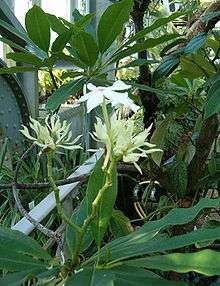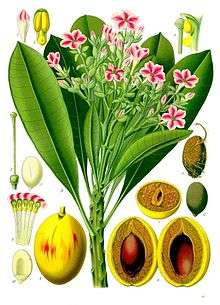Cerbera manghas
| Cerbera manghas | |
|---|---|
 | |
| Scientific classification | |
| Kingdom: | Plantae |
| Clade: | Angiosperms |
| Clade: | Eudicots |
| Clade: | Asterids |
| Order: | Gentianales |
| Family: | Apocynaceae |
| Subfamily: | Rauvolfioideae |
| Genus: | Cerbera |
| Species: | C. manghas |
| Binomial name | |
| Cerbera manghas | |
| Synonyms | |
| |
Cerbera manghas[1] (sea mango) is a small evergreen coastal tree growing up 12 metres (39 ft) tall. The shiny dark-green leaves are in spiral arrangement, ovoid in shape. The flowers are fragrant, possessing a white tubular five-lobed corolla about 3 to 5 centimetres (1.2 to 2.0 in) in diameter, with a pink to red throat. They have five stamens and the ovary is positioned above the other flower parts. The fruits are egg-shaped, 5 to 10 centimetres (2.0 to 3.9 in) long, and turn bright red at maturity.
Description

Cerbera manghas is naturally distributed from the Seychelles in the Indian Ocean eastward to French Polynesia. It occupies coastal habitats and is often associated with mangrove forests.
This tree has been introduced to Hawaii and other tropical locations as an ornamental.
Poison
The leaves and the fruits contain the potent cardiac glycoside cerberin, which is extremely poisonous if ingested.
People in olden times used the sap of the tree as a poison for animal hunting.[2]
In Madagascar, the seeds were used in ordeals called tangena, with often deadly results.
The fruit was reportedly eaten to commit suicide in the Marquesas Islands, (Whistler, W. A. 1992. Flowers of the Pacific Island Seashore).
In Hawaii Cerbera manghas is sometimes called "suicide apple".
Mythology
Because of its deadly poisonous seeds, the genus name is derived from Cerberus, the hell dog from the Greek mythology, thus indicating the toxicity of the seeds. In Madagascar, the seeds were used in sentence rituals to poison kings and queens.[2]
Uses
In Sri Lanka, this wood is used for making masks particularly because it is a light wood.
Gallery
 C. manghas flower
C. manghas flower Unripe fruit in Indonesia
Unripe fruit in Indonesia
References
- ↑ POWO: Cerbera manghas L.
- 1 2 "Cerbera manghas L." Flora Fauna Web. Retrieved October 4, 2017.
External Links

